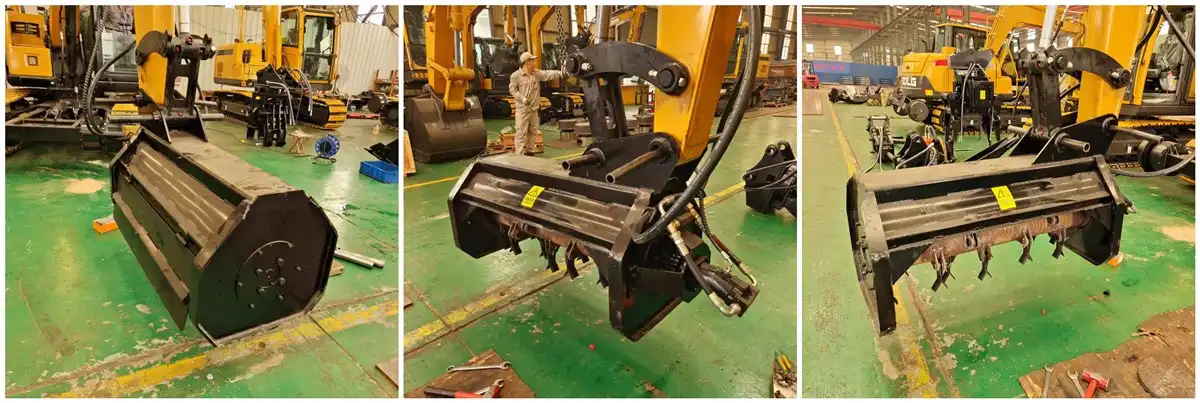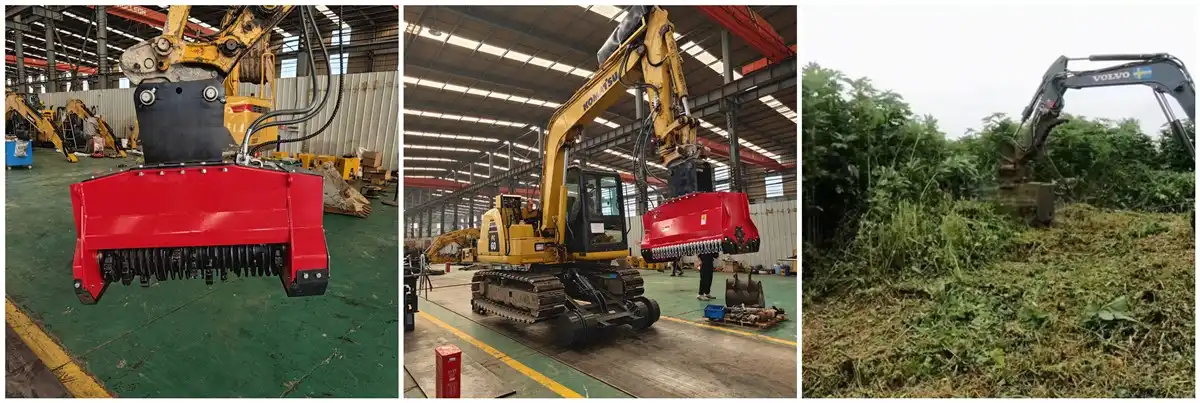How does a brush cutter work?
An excavator brush cutter is a powerful attachment designed to clear dense vegetation and small trees efficiently. This versatile tool combines the strength of an excavator with specialized cutting technology. The brush cutter works by utilizing a hydraulic drive system to power spinning blades, which slice through thick brush and saplings. Mounted on an excavator's arm, it allows for precise control and reach in challenging terrains. This innovative solution revolutionizes land clearing tasks across various industries, from forestry to railway maintenance.
Hydraulic Drive System
Powerful hydraulic motors for efficient operation
At the heart of an excavator brush cutter lies its robust hydraulic drive system. This system harnesses the excavator's existing hydraulic power to drive the cutting mechanism with impressive force. The hydraulic motors are engineered to deliver high torque and consistent power, ensuring the brush cutter can tackle even the toughest vegetation without faltering.
These motors are carefully calibrated to match the brush cutter's demands, providing the optimal balance between power and efficiency. By leveraging hydraulic technology, the brush cutter can maintain peak performance even under heavy loads, making quick work of dense undergrowth and small trees that would challenge traditional cutting methods.
Flow rate and pressure control for optimal performance
The effectiveness of an excavator brush cutter hinges on precise control of hydraulic flow rate and pressure. Advanced control systems allow operators to fine-tune these parameters, adapting to varying vegetation densities and types. This level of control ensures that the brush cutter always operates at peak efficiency, regardless of the task at hand.
By adjusting the flow rate, operators can control the speed of the cutting blades, allowing for faster rotation in light brush or a more powerful, slower cut through denser material. Pressure control, on the other hand, enables the brush cutter to maintain consistent cutting power, even when encountering sudden resistance from thicker branches or small tree trunks.
Adaptable to various excavator sizes and models
One of the key advantages of hydraulic-driven brush cutters is their adaptability. Manufacturers design these attachments to be compatible with a wide range of excavator sizes and models, from compact machines used in tight urban spaces to larger units deployed in expansive rural areas.
This versatility is achieved through modular hydraulic systems that can be easily integrated with different excavator hydraulic setups. Whether it's a 5-ton mini excavator or a 30-ton heavy-duty machine, there's likely a brush cutter model that can be seamlessly attached and operated. This flexibility makes hydraulic brush cutters a valuable asset for contractors and machinery fleets, as they can be easily transferred between different excavators as project needs change.

Spinning Blades Cut Vegetation
High-speed rotation for effective brush clearing
The cutting action of an excavator brush cutter relies on the high-speed rotation of its blades. These blades are designed to spin at velocities that allow them to slice through vegetation with minimal resistance. The rapid rotation creates a consistent cutting zone, enabling the brush cutter to clear large areas quickly and efficiently.
Typical rotational speeds can range from 2,000 to 3,000 RPM, depending on the specific model and application. This high-speed action ensures that even tough, fibrous plants are cut cleanly rather than torn or shredded, which is crucial for promoting healthy regrowth in managed areas.
Sharp blades slice through thick vegetation and saplings
The blades of an excavator brush cutter are engineered for durability and cutting performance. Made from high-grade steel and often featuring carbide tips, these blades maintain their sharpness even after prolonged use in challenging conditions. The design of the blades allows them to cut through thick vegetation and saplings up to several inches in diameter with ease.
The cutting edges are typically angled to create a slicing action rather than a chopping motion. This design reduces the energy required to cut through vegetation and minimizes the stress on the hydraulic system. As a result, the brush cutter can operate for extended periods without overheating or excessive wear.
Multiple blade options for different cutting applications
Excavator brush cutters offer versatility through a range of blade options tailored to specific cutting needs. Flat blades are ideal for general brush clearing and can handle a variety of vegetation types. Hammer flails, on the other hand, are better suited for mulching applications where finer material breakdown is desired.
For areas with tougher, woody vegetation or small trees, saw-toothed blades provide the necessary cutting power. Some models even offer quick-change blade systems, allowing operators to switch between different blade types on-site, adapting to changing terrain or project requirements without significant downtime.

Excavator-Controlled Positioning
Precise maneuvering for targeted brush removal
The integration of a brush cutter with an excavator's hydraulic arm system allows for unparalleled precision in vegetation management. Operators can leverage the excavator's controls to position the brush cutter exactly where it's needed, whether that's along a fence line, around obstacles, or on uneven terrain.
This precise control enables selective clearing, where operators can target specific areas of overgrowth while preserving desired vegetation. The ability to maneuver the brush cutter with such accuracy not only improves the efficiency of clearing operations but also minimizes environmental impact by reducing unnecessary disturbance to surrounding ecosystems.
Reach difficult areas with excavator's extended arm
One of the most significant advantages of using an excavator-mounted brush cutter is the extended reach it provides. The long arm of an excavator allows operators to clear vegetation in areas that would be inaccessible or dangerous for ground-based equipment or manual labor.
This extended reach is particularly valuable when working on steep slopes, across ditches, or in wetland areas where ground pressure must be minimized. By leveraging the excavator's arm, brush cutters can safely clear vegetation along riverbanks, railway embankments, and other challenging landscapes without putting operators at risk or causing ground disturbance.
Adjustable cutting angles for versatile landscaping
Many excavator brush cutters feature adjustable cutting angles, adding another layer of versatility to their operation. This adjustability allows operators to tackle vegetation at various angles, from horizontal cutting for general clearing to vertical trimming for shaping hedgerows or clearing along walls and structures.
Some advanced models offer 180-degree rotation capabilities, enabling the brush cutter to work effectively in both forward and reverse directions. This flexibility is invaluable for complex landscaping tasks, allowing operators to shape vegetation precisely and create clean, professional results in a wide range of environments.
Excavator brush cutters represent a significant advancement in vegetation management technology. By combining powerful hydraulic systems, high-speed cutting blades, and the precision control of an excavator, these attachments offer an efficient and versatile solution for clearing brush and small trees. Their ability to adapt to various terrains and vegetation types makes them invaluable across multiple industries, from forestry to urban development.
When looking to purchase an excavator brush cutter, it's essential to consider factors such as compatibility with your existing equipment, the specific vegetation management needs of your projects, and after-sales support. Reputable manufacturers and dealerships offer a range of options to suit various applications and budgets.
FAQ
1. What size excavator is needed for a brush cutter attachment?
Brush cutters are available for various excavator sizes, typically ranging from 5 to 30 tons. The exact size depends on the specific brush cutter model and the density of vegetation you need to clear.
2. How often should the blades on an excavator brush cutter be replaced?
Blade replacement frequency varies depending on usage and material being cut. Generally, inspect blades after every 40-50 hours of operation and replace them when they show signs of significant wear or damage.
3. Can excavator brush cutters be used in residential areas?
Yes, smaller excavator brush cutters can be used in residential areas for tasks like lot clearing or maintaining large properties. However, always check local regulations and consider noise levels when working in populated areas.
4. Are special safety precautions required when operating an excavator brush cutter?
Operators should wear appropriate personal protective equipment, including eye and ear protection. Maintain a safe distance from the cutting area, and ensure the work zone is clear of people and animals. Always follow manufacturer safety guidelines.
5. How does the environmental impact of using an excavator brush cutter compare to manual clearing methods?
When used responsibly, brush cutters can be more environmentally friendly than manual methods. They allow for selective clearing, reduce soil disturbance, and can mulch vegetation on-site, returning nutrients to the soil.
China Excavator Brush Cutter
TianNuo Machinery, a leading manufacturer in China, offers high-quality brush cutters designed for optimal performance and durability. Their product line includes brush cutters compatible with various excavator models, catering to diverse industry needs. TianNuo's excavator brush cutters feature advanced hydraulic systems, ensuring efficient operation in challenging environments. For those interested in exploring TianNuo's range of excavator attachments, including brush cutters, railway maintenance equipment, and specialized engineering arms, contact us at raymiao@stnd-machinery.com. TianNuo's commitment to innovation and quality makes it a trusted choice for professionals in the construction, forestry, and land management sectors.
References
- Smith, J. (2023). Advances in Hydraulic Excavator Attachments. Journal of Construction Equipment Technology, 45(2), 78-92.
- Brown, A. et al. (2022). Environmental Impact Assessment of Mechanical Vegetation Management Methods. Forestry and Land Management Review, 18(4), 215-230.
- TianNuo Machinery. (2023). Excavator Brush Cutter Specifications and Performance Data. Technical Report Series, 7.
- Johnson, L. (2021). Optimizing Hydraulic Systems for Heavy Machinery Applications. Hydraulic Engineering Quarterly, 33(1), 42-56.
- International Association of Land Clearing Contractors. (2023). Best Practices in Vegetation Management and Land Clearing. Industry Guidelines, 5th Edition.
- Zhang, Y. and Lee, K. (2022). Comparative Analysis of Brush Cutting Technologies in Railway Maintenance. Railway Engineering and Maintenance Journal, 29(3), 180-195.
About Author: Arm
Arm is a leading expert in the field of specialized construction and railway maintenance equipment, working at Tiannuo Company.

